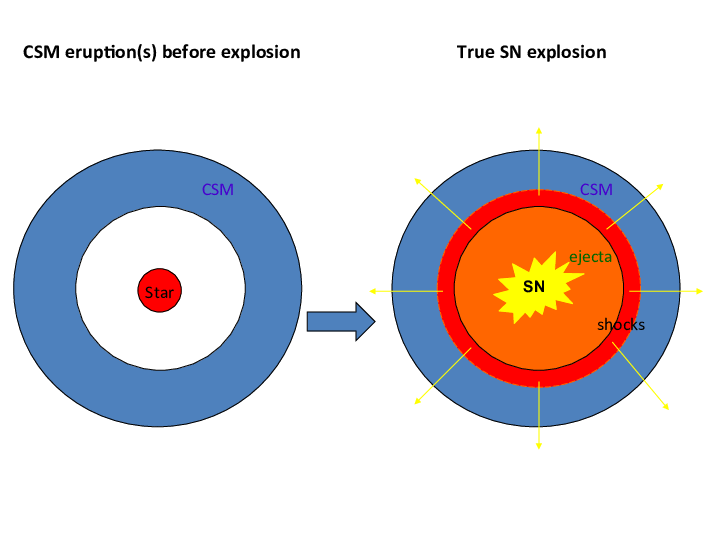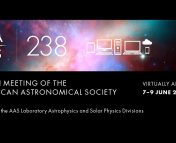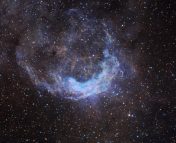Title: 3D Hydrodynamics of Pre-supernova Outbursts in Convective Red Supergiant Envelopes
Authors: Benny T.-H. Tsang, Daniel Kasen, Lars Bildsten
First Author’s Institution: Department of Astronomy and Theoretical Astrophysics Center, University of California, Berkeley, CA 94720, USA
Status: full text available on the arXiv. Submitted to the Astrophysical Journal
Alright, I know what you’re thinking, “what do my digestive problems (for the hopefully very few of you) have to do with a star’s last, quite spectacular, goodbye?”.
Well, unlike most humans, stars don’t possess working intestines, and their outbursts – supernovae – are far more impressive than anything we can manage.
Now, there are many different supernovae (SNe), but they are broadly split into two categories: type I and type II SNe. In type I we typically see no hydrogen (here’s an example why), while type II SNe do contain hydrogen, we will talk about this last type here.
Red Supergiant Burps and Interacting Supernovae
Before Red Supergiants go supernova, they are prone to breathtaking belches, called pre-Supernova outbursts. These outbursts push out huge amounts of gas from the star which is left in the so-called circumstellar medium (CSM) – the star’s direct neighborhood. If this neighborhood is filled with enough gas when a star dies, the star’s Supernova will push against and interact with this material, shown in
Figure 1. This interplay between the material around the star and the supernova can actually be observed here on Earth, and is known as a type IIn or interacting Supernova.

How visible this interaction is depends mostly on how much material is in the stellar neighborhood. This depends again on how much gas the star decides to throw out, and also on how these pre-Supernova outbursts (or burps) are actually forming.
The authors of today’s paper show that this has a lot to do with convection in the Red Supergiant.
Red Supergiant boiling pot
Simulating these Red Supergiant outbursts shortly before they go Supernova is not new, so we already know why these pre-Supernova outbursts happen:
- Increasingly unstable nuclear fusion in the core of the star causes powerful gravity waves (not to be confused with gravitational waves).
- Large-scale convection in the Red Supergiant carries around material in the star which can destabilize the nuclear fusion in the core, giving a very variable energy output.
- Pair-instability can cause the core’s energy output to go through cycles of drops and spikes
- A binary companion star can disturb the Red Supergiant enough to cause a temporarily unstable star.
The bottom line is that some process releases a large amount of extra energy inside the star which, depending on how the star reacts to this energy release, can lead to different outbursts of gas.Until now, the simulations of these outbursts have usually been performed in spherical symmetry, meaning that the simulation of the outburst looks exactly the same from any direction. You can also see this as a simulation on a single line of sight from the outside of the star inwards (a.k.a. 1-dimensional).
The problem with this approach is that you cannot simulate convection this way. To deal with convection, the authors of today’s paper took the brute-force approach and did a fully 3D simulation. They simulated the region of the star outside the nuclear core (called the envelope) and started with a large energy release at the innermost part of their simulation. The authors considered different styles of energy release in the envelope. These included:
- A large, sudden energy release, comparable to the energy needed by gravity to keep the star together. This can cause a mass ejection, quite like our sun but on much larger scales.
- A slow release of energy,which causes a much more steady stream of mass flowing away from the star instead of an explosive loss of mass.
- They also took into account the direction of energy release, which influences how (and where to) the pre-Supernova outburst will occur.
A snapshot of their simulation is shown in Figure 2. Here, we see both the envelope density on the left and the velocity of the envelope gas in the radial direction on the right. In the velocity graph we can see zones both moving away from the star and falling back towards the core. These are the same as convection cells we can find in daily life – like in a pot of boiling water.

The convection cells leave ‘holes’ in the envelope, these are channels of lower density in the envelope from the outside to inner parts of the star. Through these channels, much more gas can escape than would be possible without convection.
We can also see this in Figure 3: the simulation on the left panel was done with convection and has a much higher amount of mass lost than the simulation on the right which was computed without convection. These channels of low density appear where most of the mass escapes in the convection simulation.

This paper shows the necessity of taking convection in 3D into account, where the loss of mass from the pre-Supernova outbursts has mostly been underestimated. This increases the amount of gas in the neighborhood of the Red Supergiant, ultimately affecting how the interacting supernova will look like to us on Earth.
Astrobite edited by Sasha Warren.
Featured image credit: Wallpaperflare.com




